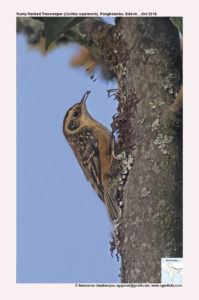Rusty-flanked Treecreeper

Rusty-flanked Treecreeper Certhia nipalensis
Etymology :
- Certhia : Greek word kerthios small tree-dwelling insect-eating bird mentioned by Aristotle
- Nipalensis: From Nepal
Distribution in India: Resident of Himalayas.
Description: Size of 14 cm; wt. of 8–12g. It is a rather dark Treecreeper with strong contrast below between off-white throat and breast and cinnamon lower underparts, and relatively short and straight bill. In fresh plumage (Sept–Mar), it has buff feathers of forehead that are fringed dark brown, crown, nape and upper mantle are sooty-brown, buff shaft streaks broadening towards feather tips becoming broadest and palest on upper mantle, which appears spotted; lores are blackish, cheek is mottled buff and dark brown, ear-coverts are sooty black with few fine buff streaks, supercilium are pale buff that are narrow and poorly marked before eye and connecting with pale buff side of neck. The lower mantle and scapulars are dull cinnamon-buff with slightly paler shaft streaks and sooty-brown fringes that appears scalloped. The back, rump and uppertail-coverts are rich cinnamon-rufous; upperwing-coverts are sooty brown, lesser and median coverts are with buff spot near tip, greater coverts have outer webs tipped with rich buff and narrowly fringed orange-buff. The alula and primary coverts are sooty brown, Alula is broadly tipped buff; tertials are pale grey-brown, becoming blackish-brown towards tips, shaft is pale buff and outer web are with pale buff fringe and tip and subterminal buff notch or band. The primaries and secondaries are dark brown; all these except outer four primaries are with broad pale band across feather, buff on outer web and contrastingly white on concealed inner web.Primaries P5-P6 is paler towards base and tip, P7-P10 and secondaries have dull buff slot near tip of outer web and dull paler tip. The tail is medium grey-brown, shafts are very long and rufous-buff; chin is whitish, throat, breast and centre of belly are white and washed buff, side of breast is brownish-cinnamon. The flanks, belly, vent and thighs are cinnamon, becoming rufous-cinnamon on rear thighs, undertail-coverts are tipped slightly paler; in worn plumage (Apr–Aug) upperparts are slightly duller, underparts are whiter, chin to centre of belly are very white and contrasting strongly with more restricted area of cinnamon. The iris is red-brown to brown; bill is dark horn-brown to black, cutting edges and base of lower mandible is pinkish-white; legs are pale fleshy-horn to brown. Both the sexes are similar. The juvenile is as adult but streaks on crown and nape narrower and buffier, feathers of lower back to uppertail-coverts are duller with dark brown subterminal band, duller below, darker feather fringes on sides of throat, breast, belly and flanks form irregular faint scalloping, contrasting dark colour more restricted. It is found during breeding season in upper temperate zone, extending marginally into subalpine zone, in moist broadleaf evergreen forest, especially oak, also coniferous and mixed deciduous forests and pure stands of rhododendron. In non-breeding season it descends into broadleaf forests in lower temperate zone. It is found from 2300–3660 m,in breeding and in Nov–Feb descends to 1400 m.
Food habits:
It eats arthropods. It forages on trunks and lower branches of trees, including underside of large horizontal boughs, searching for food among epiphytes. It is seldom found high up in branches. It occurs singly or in loose pairs; sometimes in small flocks in pre-breeding period. It may join mixed-species foraging flocks.
Breeding habits: They breed in Apr–Jun. The nest is a simple, loose construction of dry moss, lined with a few feathers above ground in fissure in a tree. They lay a clutch of 2- 3 eggs. The nestlings are fed by both sexes.